Cisco Linksys WPC11-V31 Wireless Network PC Radio Card User Manual wpc11 ver3 0 user guide
Cisco-Linksys, LLC Wireless Network PC Radio Card wpc11 ver3 0 user guide
Contents
- 1. DoC Statement
- 2. Users Manual 1
- 3. Users Manual 2
Users Manual 1
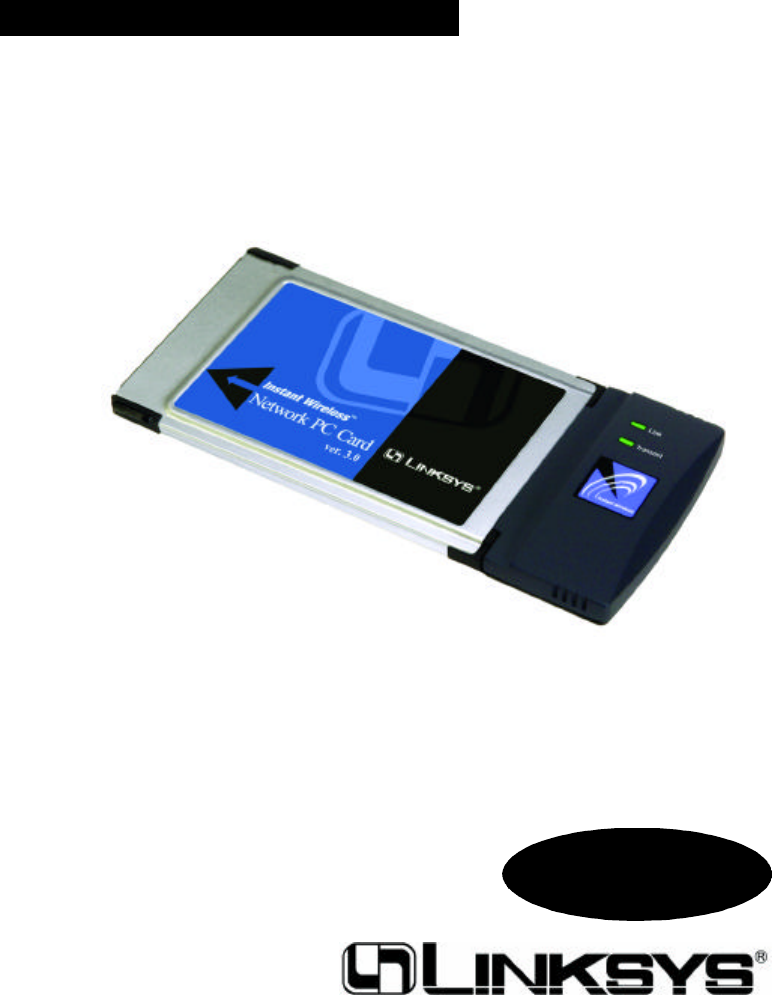
Instant WirelessTM Series
Network PC Card
User Guide
Use this Guide to install:
WPC11 ver. 3.0

COPYRIGHT & TRADEMARKS
Copyright © 2002 Linksys, All Rights Reserved. Instant Wireless™ is a registered trade-
mark of Linksys. Microsoft, Windows, and the Windows logo are registered trademarks
of Microsoft Corporation. All other trademarks and brand names are the property of their
respective proprietors.
LIMITED WARRANTY
Linksys guarantees that every Instant Wireless™ Network PC Card ver. 3.0 is free from
physical defects in material and workmanship for one year from the date of purchase,
when used within the limits set forth in the Specifications chapter of this User Guide. If
these products prove defective during this warranty period, call Linksys Technical
Support in order to obtain a Return Authorization Number. BE SURE TO HAVE YOUR
PROOF OF PURCHASE AND A BARCODE FROM THE PRODUCT’S PACKAGING ON
HAND WHEN CALLING. RETURN REQUESTS CANNOT BE PROCESSED WITHOUT
PROOF OF PURCHASE. When returning a product, mark the Return Authorization
Number clearly on the outside of the package and include your original proof of pur-
chase. All customers located outside of the United States of America and Canada shall
be held responsible for shipping and handling charges.
IN NO EVENT SHALL LINKSYS’ LIABILITY EXCEED THE PRICE PAID FOR THE PROD-
UCT FROM DIRECT, INDIRECT, SPECIAL, INCIDENTAL, OR CONSEQUENTIAL DAM-
AGES RESULTING FROM THE USE OF THE PRODUCT, ITS ACCOMPANYING SOFT-
WARE, OR ITS DOCUMENTATION. LINKSYS DOES NOT OFFER REFUNDS FOR ANY
PRODUCT. Linksys makes no warranty or representation, expressed, implied, or statuto-
ry, with respect to its products or the contents or use of this documentation and all
accompanying software, and specifically disclaims its quality, performance, mer-
chantability, or fitness for any particular purpose. Linksys reserves the right to revise or
update its products, software, or documentation without obligation to notify any individ-
ual or entity. Please direct all inquiries to:
Linksys P.O. Box 18558, Irvine, CA 92623.
FCC STATEMENT
This product has been tested and complies with the specifications for a Class B digital
device, pursuant to Part 15 of the FCC Rules. These limits are designed to provide rea-
sonable protection against harmful interference in a residential installation. This equip-
ment generates, uses, and can radiate radio frequency energy and, if not installed and
used according to the instructions, may cause harmful interference to radio communi-
cations. However, there is no guarantee that interference will not occur in a particular
installation. If this equipment does cause harmful interference to radio or television
reception, which is found by turning the equipment off and on, the user is encouraged to
try to correct the interference by one or more of the following measures:
• Reorient or relocate the receiving antenna
• Increase the separation between the equipment or devices
• Connect the equipment to an outlet other than the receiver’s
• Consult a dealer or an experienced radio/TV technician for assistance
FCC Caution: To assure continued compliance, (example - use only shielded interface cables
when connecting to computer or peripheral devices). Any changes or modifications not expressly
approved by the party responsible for compliance could void the user's authority to operate this
equipment.
IMPORTANT NOTE: FCC Radiation Exposure Statement:
This equipment complies with FCC radiation exposure limits set forth for an uncontrolled
environment. This equipment should be installed and operated with minimum distance 2.5cm
between the radiator & your body.
This transmitter must not be co-located or operating in conjunction with any other antenna or
transmitter.
UG-WPC11 ver.3.0-011702B KL

Table of Contents
Chapter 1: Introduction 1
The Instant WirelessTM Network PC Card ver. 3.0 1
Features 1
Package Contents 2
System Requirements 2
Chapter 2: Planning Your Wireless Network 3
Network Topology 3
Roaming 3
Chapter 3: Installing the Drivers and Configuration Utility for
Windows 95, 98, ME and 2000 4
Before You Start 4
Running the Auto Driver Installation 4
Ad-Hoc Versus Infrastructure Mode 8
Infrastructure Mode 9
Ad-Hoc Mode 11
Chapter 4: Installing the Drivers and
Configuration Utility for Windows XP 14
Chapter 5: Installing the Network PC Card 16
Chapter 6: Installing the Drivers and
Configuration Utility for Windows NT 17
Overview 17
Installing the Network PC Card in Your Notebook PC 17
Installing the Drivers for Windows NT 18
Installing the Configuration Utility for Windows NT 30
Chapter 7: Configuration Utility 30
Using the Configuration Utility 30
Chapter 8: Installing Network Protocols 39
Network PC Card
Instant Wireless
TM
Series
Chapter 9: Advanced Properties 41
Advanced Properties for Windows 95, 98, ME, and 2000 41
Advanced Properties for Windows NT 49
Chapter 10: Troubleshooting 56
Common Problems and Solutions 56
Frequently Asked Questions 57
Chapter 11: Glossary 61
Chapter 12: Specifications 68
Environmental 68
Chapter 13: Warranty Information 69
Chapter 14: Contact Information 70
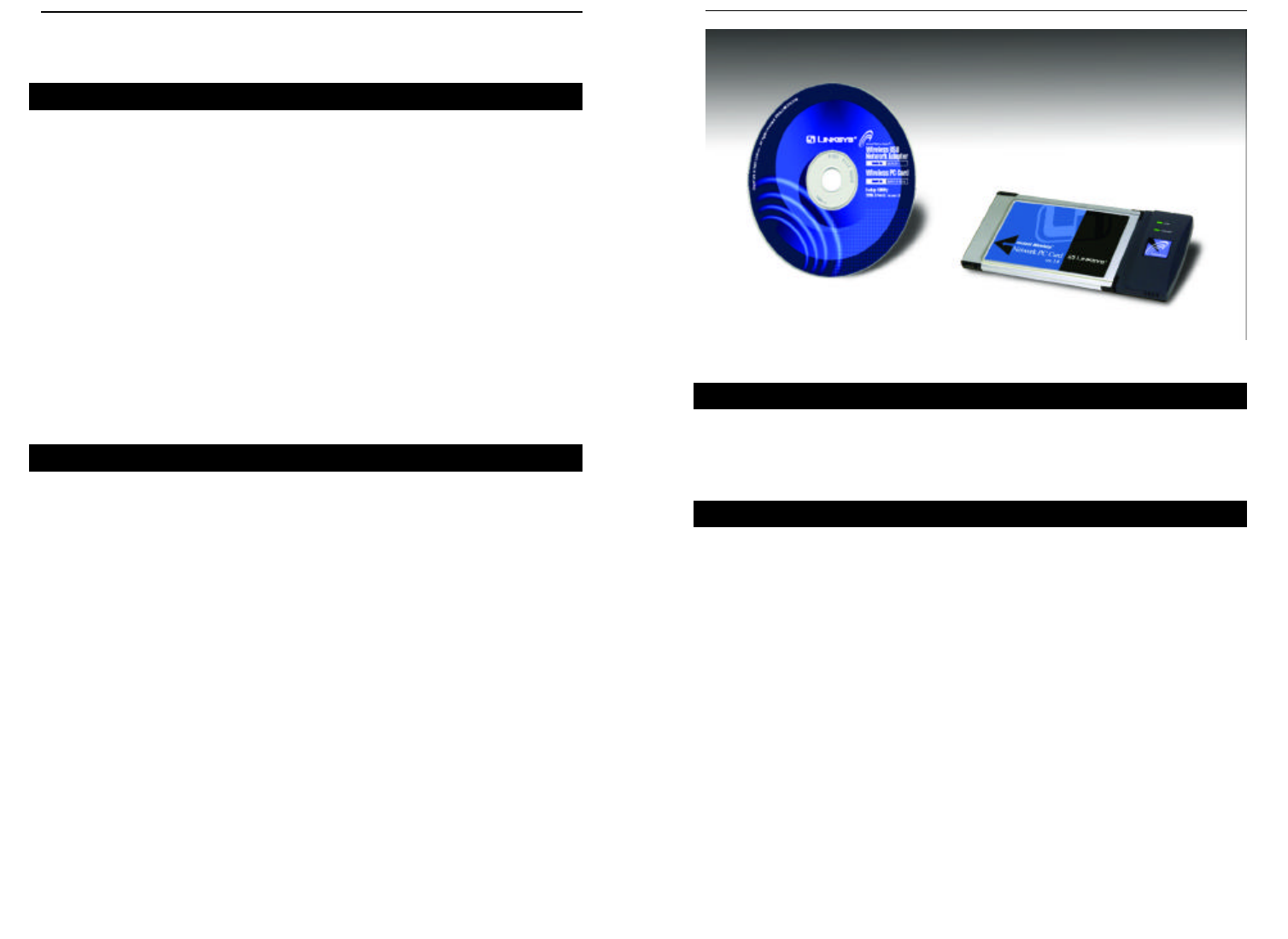
2
• One Instant WirelessTM Network PC Card ver. 3.0
• One Setup Utility CD-ROM (User Guide on CD)
• Quick Installation insert and Registration Card (not shown)
• A 16-bit PCMCIA Type II or Type III slot
• PCMCIA revisions 2.10 compliant card and socket services
• Windows 95, 98, Millennium, NT, 2000, or XP
• 600 Kbytes of free disk space for utility and driver installation
Package Contents
System Requirements
Instant Wireless
TM
Series
1
Chapter 1: Introduction
Put the “mobile” back into mobile computing! Whether you’re at your desk or
in the boardroom, the Instant Wireless™ Network PC Card allows you to share
printers, files, and other resources anywhere within your LAN infrastructure,
increasing your productivity and keeping you “in touch.”
The Instant Wireless™ Network PC Card now has a new, higher-powered
antenna that provides a greater range than ever. The increased sensitivity helps
filter out interference and “noise” to keep your signal clear. Improved error
correction in the chipset keeps you operating at higher transmission rates for
longer distances. And, since you only need one Type II or III PCMCIA slot,
you’re free to use your other slots for additional accessories.
Ready to run in Type II or III PCMCIA-equipped notebook PCs running
Windows 95, 98, Millennium, NT, 2000, and XP, the Instant Wireless™
Network PC Card ver. 3.0 is truly a “must-have” for all notebook PC users.
•11 Mbps High-Speed Data Transfer Rate
•Compatible with Virtually All Major Network Operating Systems
•Plug-and-Play Operation Provides Easy Setup
•Integrated Equalizer Recovers Weak Signals and Enhances Sensitivity
•Sturdy Metal Design with Integrated Antenna
•Works with All Standard Internet Applications
•Interoperable with IEEE 802.11b (DSSS) 2.4GHz-Compliant Equipment
•Clear Channel Assessment Increases Network Throughput
•Hardware Buffer Chaining Provides High Performance While Reading and
Writing Buffers
•Capable of up to 128-Bit WEP
•Free Technical Support—24 Hours a Day, 7 Days a Week for North America
Only
•1-Year Limited Warranty
Features
The Instant WirelessTM Network PC Card ver. 3.0
Figure 1-1
Network PC Card
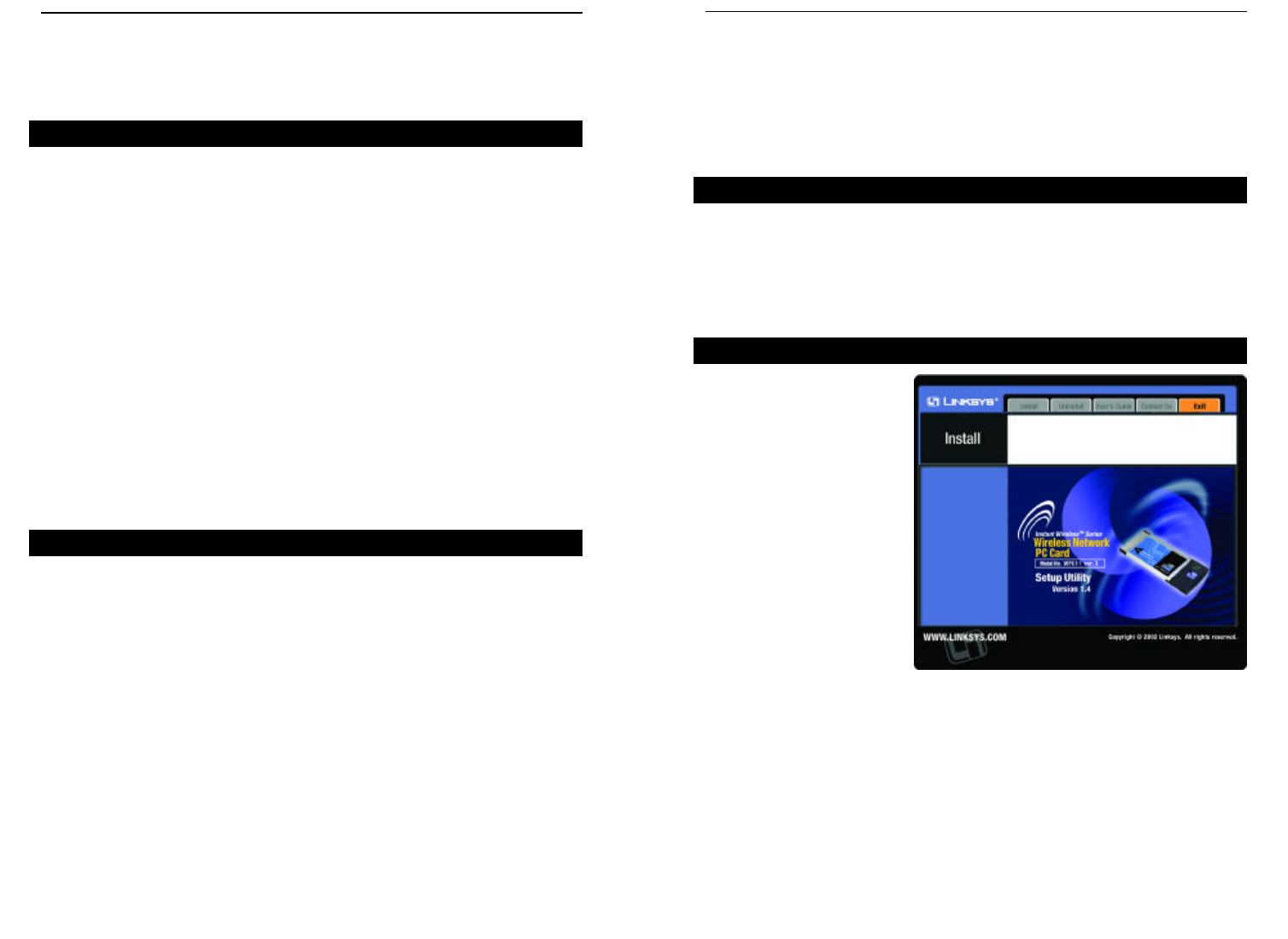
43
Chapter 3: Installing the Drivers
and Configuration Utility for
Windows 95, 98, ME, and 2000
Your new Linksys Instant Wireless™ Network PC Card ver. 3.0 comes with an
automated software installation procedure for Windows 95, 98, Millennium,
and 2000. Windows NT or XP users should refer to the next section. This
new procedure automatically installs the drivers and Configuration Utility
before you insert the Card into your PC, so there’s no searching for the location
of drivers. Again, this step is taken before inserting the Card into your PC.
1. Before installing your
card, insert the Setup
Utility CD into your
CD-ROM drive. Unless
you have deactivated the
auto-run feature of
Windows, the screen
shown in Figure 2-1
should appear automati-
cally.
If this screen does not appear automatically, you can access the installation
by clicking the Start button and choosing Run. In the drop-down box pro-
vided, type D:\setup.exe (where D: is the letter of your CD-ROM drive).
Alternately, double-click My Computer and double-click the CD-ROM
drive where the Setup Utility CD is located. Double-click the Setup.exe icon
in the folder that appears.
Before You Start
Running the Auto Driver Installation
Network PC Card
Chapter 2: Planning Your Wireless
Network
Awireless LAN is exactly like a regular LAN, except that each computer in the
LAN uses an Instant Wireless™ Network PC Card ver. 3.0 to connect to the
network through a wireless connection. Computers in a wireless LAN must be
configured to share the same radio channel.
The Instant Wireless™ Network PC Card ver. 3.0 provides LAN access for
wireless workstations. An integrated wireless and wired LAN is called an
Infrastructure configuration. A group of Instant Wireless™ Network PC Card
ver. 3.0 users and an Access Point compose a Basic Service Set (BSS). Each
PC equipped with an Instant Wireless™ Network PC Card ver. 3.0 in a BSS can
talk to any computer in a wired LAN infrastructure via the Access Point.
An infrastructure configuration extends the accessibility of an Instant
Wireless™ Network PC Card ver. 3.0 PC to a wired LAN, and doubles the
effective wireless transmission range for two PCs equipped with an Instant
Wireless™ Network PC Card ver. 3.0. Since the Access Point is able to for-
ward data within its BSS, the effective transmission range in an infrastructure
LAN is doubled.
Infrastructure mode also supports roaming capabilities for mobile users. More
than one BSS can be configured as an Extended Service Set (ESS). This con-
tinuous network allows users to roam freely within an ESS. All PCs, equipped
with an Instant Wireless™ Network PC Card ver. 3.0, within one ESS must be
configured with the same ESS ID.
Before enabling an ESS with roaming capability, selecting a feasible radio
channel and optimum Access Point position is recommended. Proper Access
Point positioning combined with a clear radio signal will greatly enhance per-
formance.
Roaming
Network Topology
Figure 2-1
Instant Wireless
TM
Series
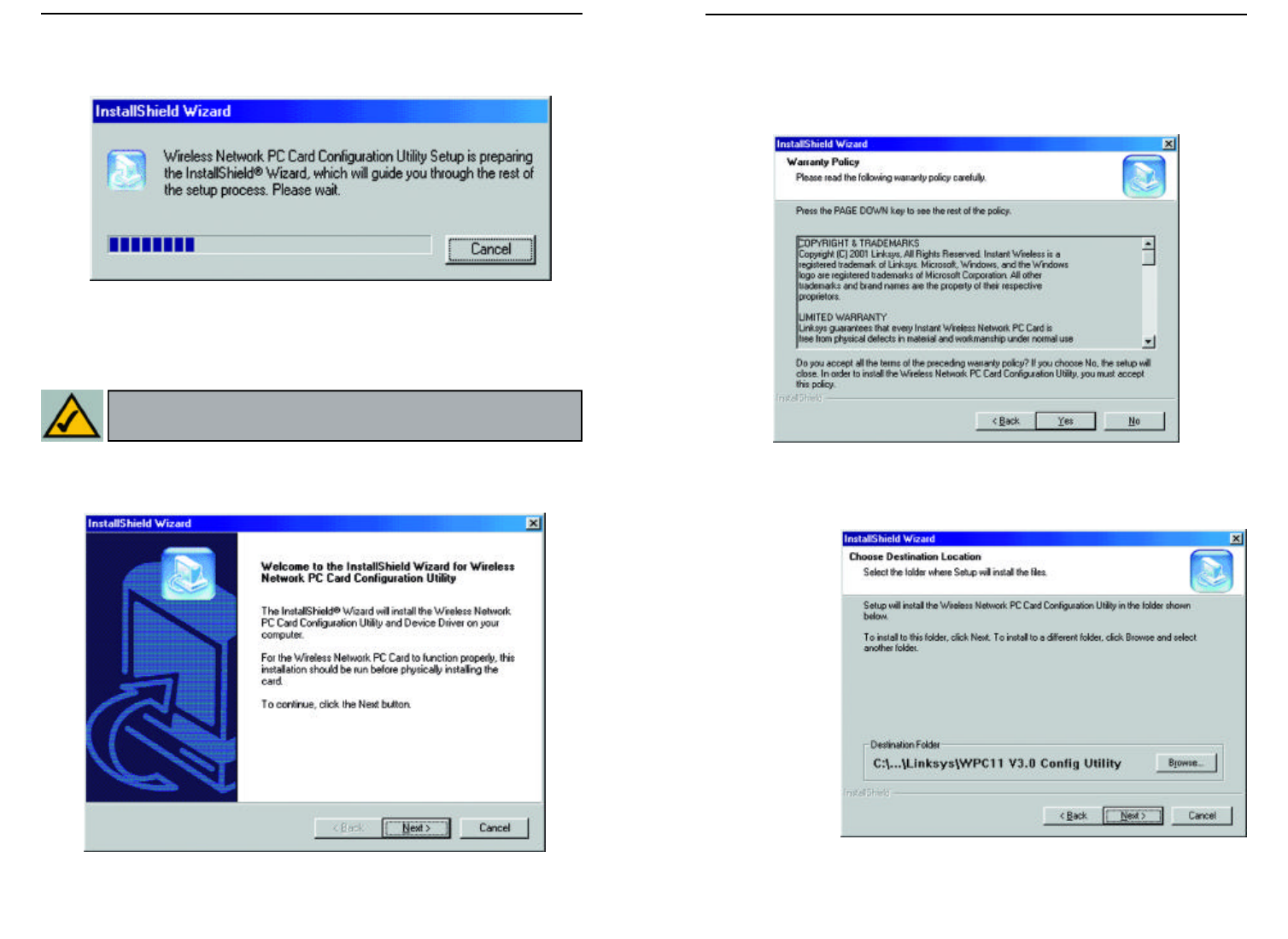
65
4. Figure 2-4 shows the Warranty Policy screen. Read the entire policy by
pressing the Page Down button on your keyboard or by using the on-screen
scroll bar. Click on the Yes button if you agree, or No if you disagree.
Clicking No will terminate the installation. If you click Yes, the installation
will continue.
5. The screen in Figure 2-5 will appear next, requesting the folder into which
the Configuration Utility will be installed. To install the Configuration
Utility in the
default directo-
ry (recom-
mended), click
the Next but-
ton. If you
prefer to install
the Utility in
another direc-
tory, click the
Browse button,
and locate the
preferred
directory.
Then, click the
Next button.
2. The first tab across the top of the screen, labeled Install, should now be high-
lighted. Click the Install button. A screen similar to that shown in Figure
2-2 should appear, indicating that Windows is preparing the installation.
If, for whatever reason, you need to abort or terminate the installation, press
the Cancel button at any time during the installation. Otherwise the instal-
lation will continue automatically.
3. The screen in Figure 2-3 will appear next, indicating that Windows is ready
to continue the installation. Click the Next button.
Note: If you stop the installation before it has finished, you will have to
run the installation completely again before installing your hardware.
Network PC Card
Figure 2-2
Figure 2-3
Figure 2-4
Figure 2-5
Instant Wireless
TM
Series
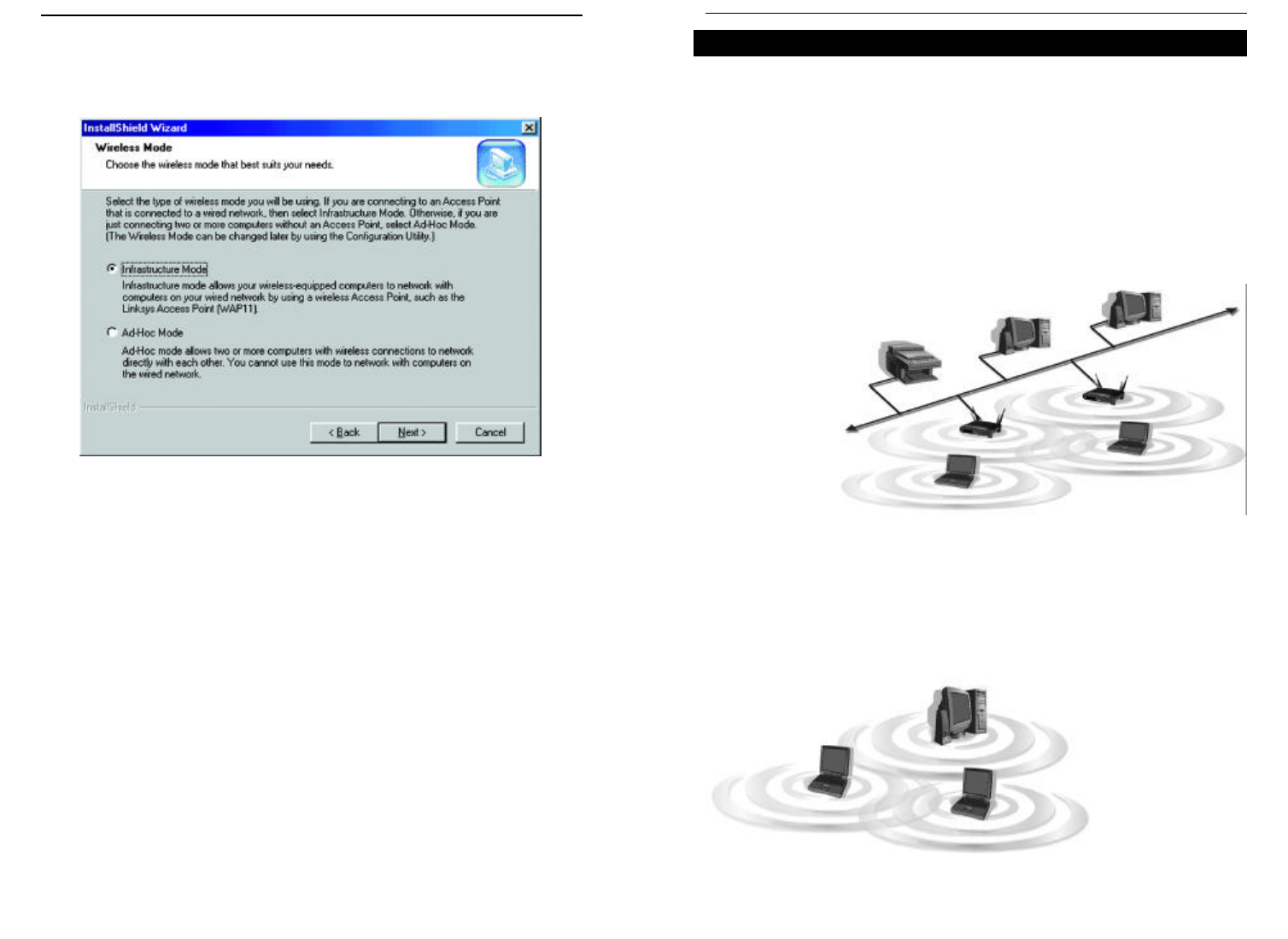
Unlike wired networks, wireless networks have two different modes in which
they may be set up: Infrastructure and Ad-Hoc. Choosing between these two
modes depends on whether or not the wireless network needs to share data or
peripherals with a wired network or not.
If the computers on the wireless network need to be accessible by a wired net-
work or need to share a peripheral, such as a printer, with the wired network
computers, the wireless network should be set up in the Infrastructure mode.
The basis of Infrastructure mode centers around an access point, which serves
as the main point of communications in a wireless network (see Figure 2-7).
Access points transmit data to PCs equipped with wireless network cards,
which can roam
within a certain
radial range of the
access point.
Multiple access
points can be
arranged to work
in succession to
extend the roam-
ing range, and can
be set up to com-
municate with
your Ethernet
hardware as well.
If the wireless network is relatively small and needs to share resources only
with the other computers on the wireless network, then the Ad-Hoc mode can
be used (shown in Figure 2-8). Ad-Hoc mode allows computers equipped with
wireless Network PC Cards to communicate directly with each other, eliminat-
ing the need for an access point. The drawback of this mode is in the fact that,
in Ad-Hoc mode, wireless-equipped computers are not able to communicate
with computers on a
wired network. And,
of course, communi-
cation between the
wireless-equipped
computers is limited
by the distance and
interference directly
between them.
87
Ad-Hoc versus Infrastructure Mode
6. When the screen shown in Figure 2-6 appears, choose either Infrastructure
mode or Ad-Hoc mode. If you are unsure whether to choose Infrastructure
or Ad-Hoc, refer to the next section for more information. Once you have
made your choice, click the Next button.
Network PC Card
Figure 2-6
Figure 2-7
Figure 2-8
Instant Wireless
TM
Series
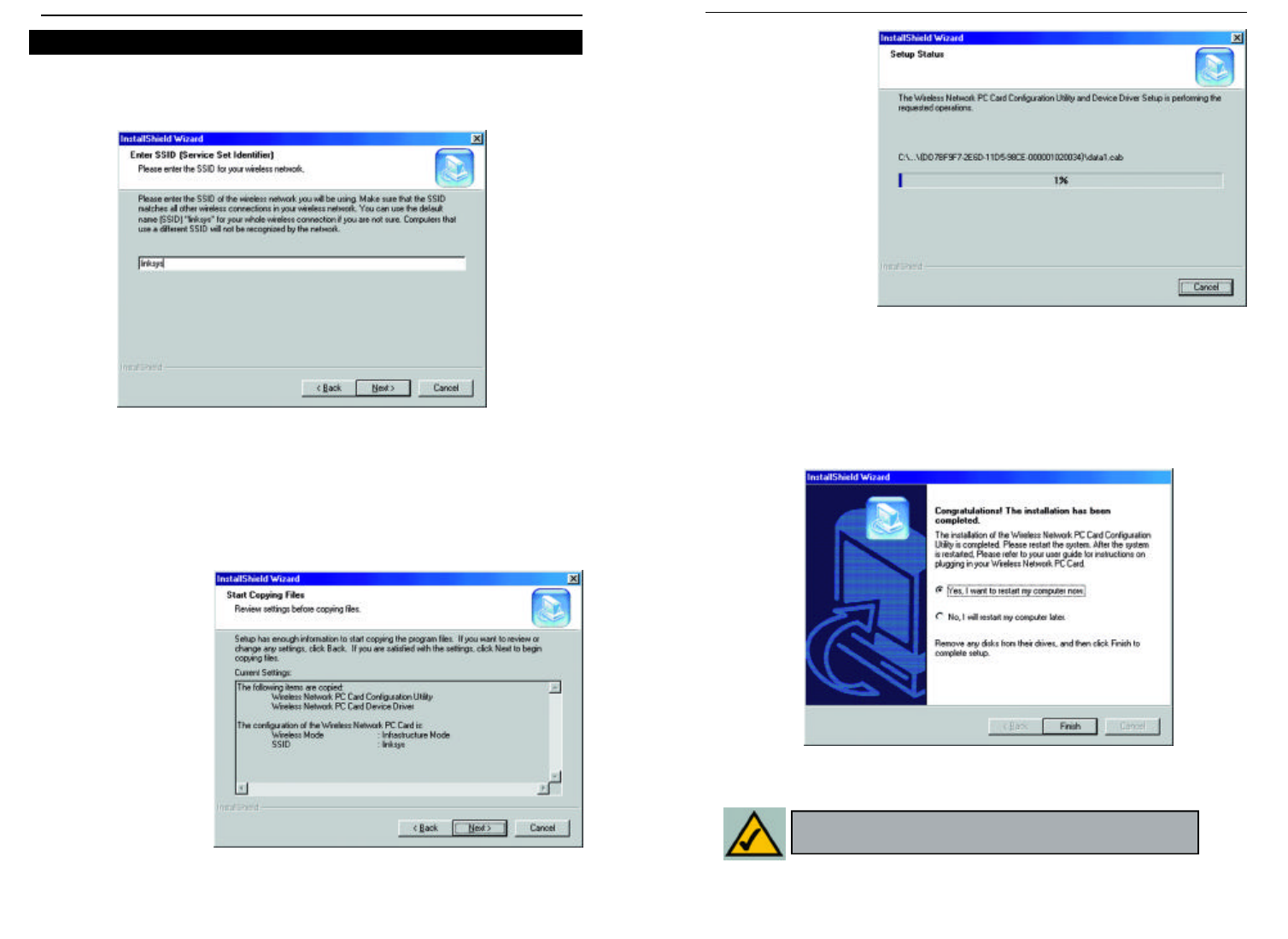
3. The screen shown
in Figure 2-11 will
appear, indicating
that all of the
appropriate files
are being copied
onto your drive.
Click the Cancel
button if you need
to stop the installa-
tion for any reason.
4. Once Windows has finished copying the necessary files, the screen shown
in Figure 2-12 will appear. In order for the drivers to be installed properly,
you must restart your computer. If you choose to do it now, select Yes, I
want to restart my computer now. If you do not want to do it now,
choose No, I will restart my computer later. Once you have made your
choice, click the Finish button to continue.
10
1. If you have chosen Infrastructure mode, the following screen (Figure 2-9)
will appear. If you have chosen Ad-Hoc mode, skip to the next section,
titled “Ad-Hoc Mode”.
You will be prompted to enter an SSID value in the box provided. The
SSID may be up to 32 characters in length. This may include any character
on the keyboard, keeping in mind that the SSID is case sensitive. All SSID
values on your wireless network must match. If you are unsure, use the
default value of “linksys.” Then, click the Next button.
2. The Review
Settings screen
(Figure 2-10) will
appear next. Verify
that all the settings
are correct and
click the Next but-
ton to continue.
9
Note: Restart the computer and go to Chapter 3:
Installing the Network PC Card for further instructions.
Infrastructure Mode
Figure 2-9
Figure 2-10
Figure 2-11
Figure 2-12
Instant Wireless
TM
Series
Network PC Card
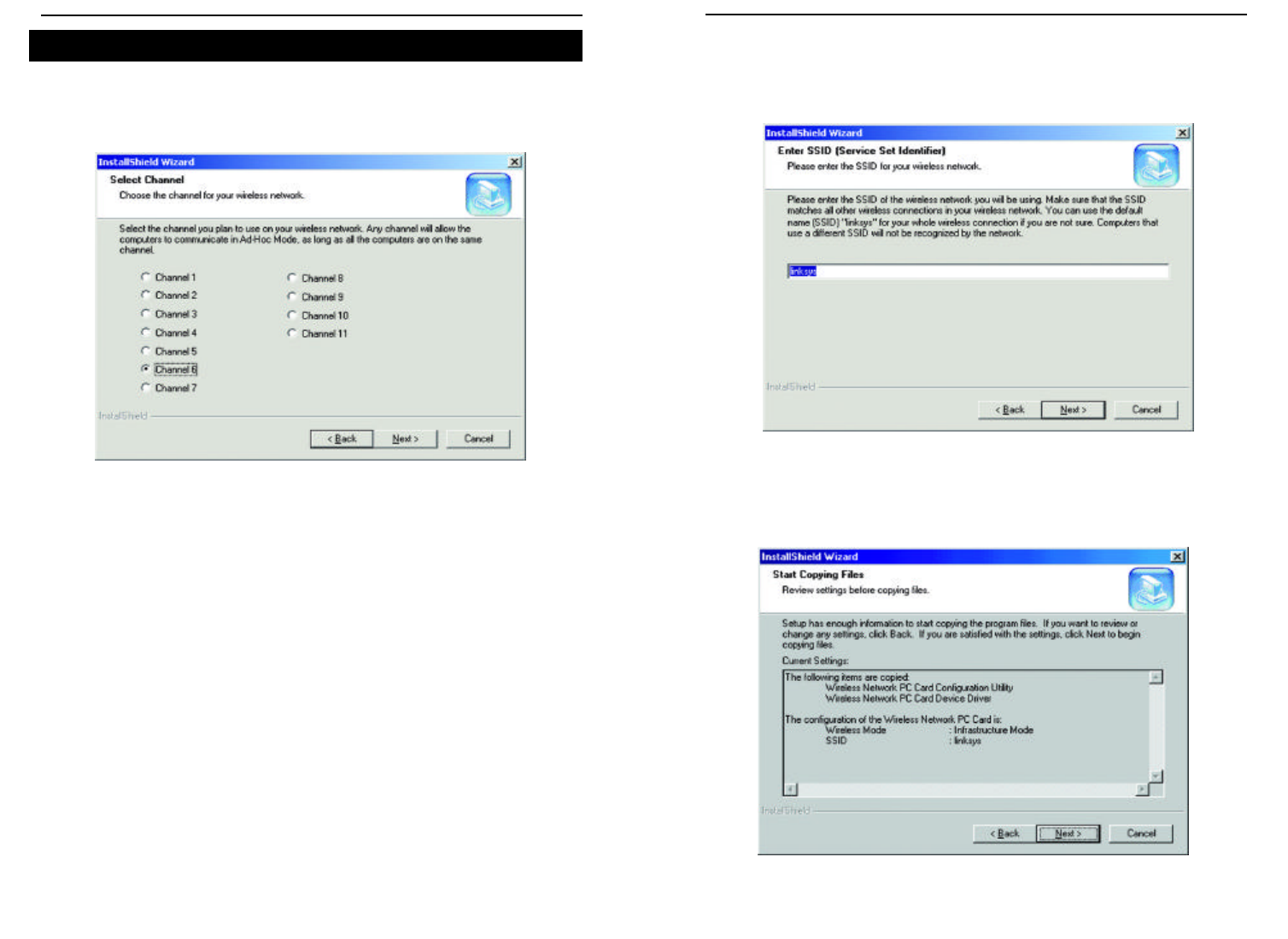
11
2. The screen shown in Figure 2-14 should appear. You will be prompted to
enter an SSID value in the field provided. All SSID values on your wire-
less network must match. If you are unsure, use the default value of
“linksys.” Then, click the Next button.
3. The next screen to appear (Figure 2-15) will be the Review Settings screen.
Verify that all the settings are correct and click the Next button to contin-
ue.
Network PC Card
1. If you have chosen Ad-Hoc mode, the following screen will appear. (See
Figure 2-13.) If you have chosen Infrastructure mode, refer to the previ-
ous section, titled “Infrastructure Mode”.
You will be prompted to choose a Channel from the list provided. All
computers on your wireless network must be using the same channel in
order to communicate with each other. If you are unsure about which chan-
nel to use, select the default channel (Channel 6). Once you have chosen
your channel, click the Next button.
Ad-Hoc Mode
Figure 2-13
Figure 2-14
Figure 2-15
Instant Wireless
TM
Series
12
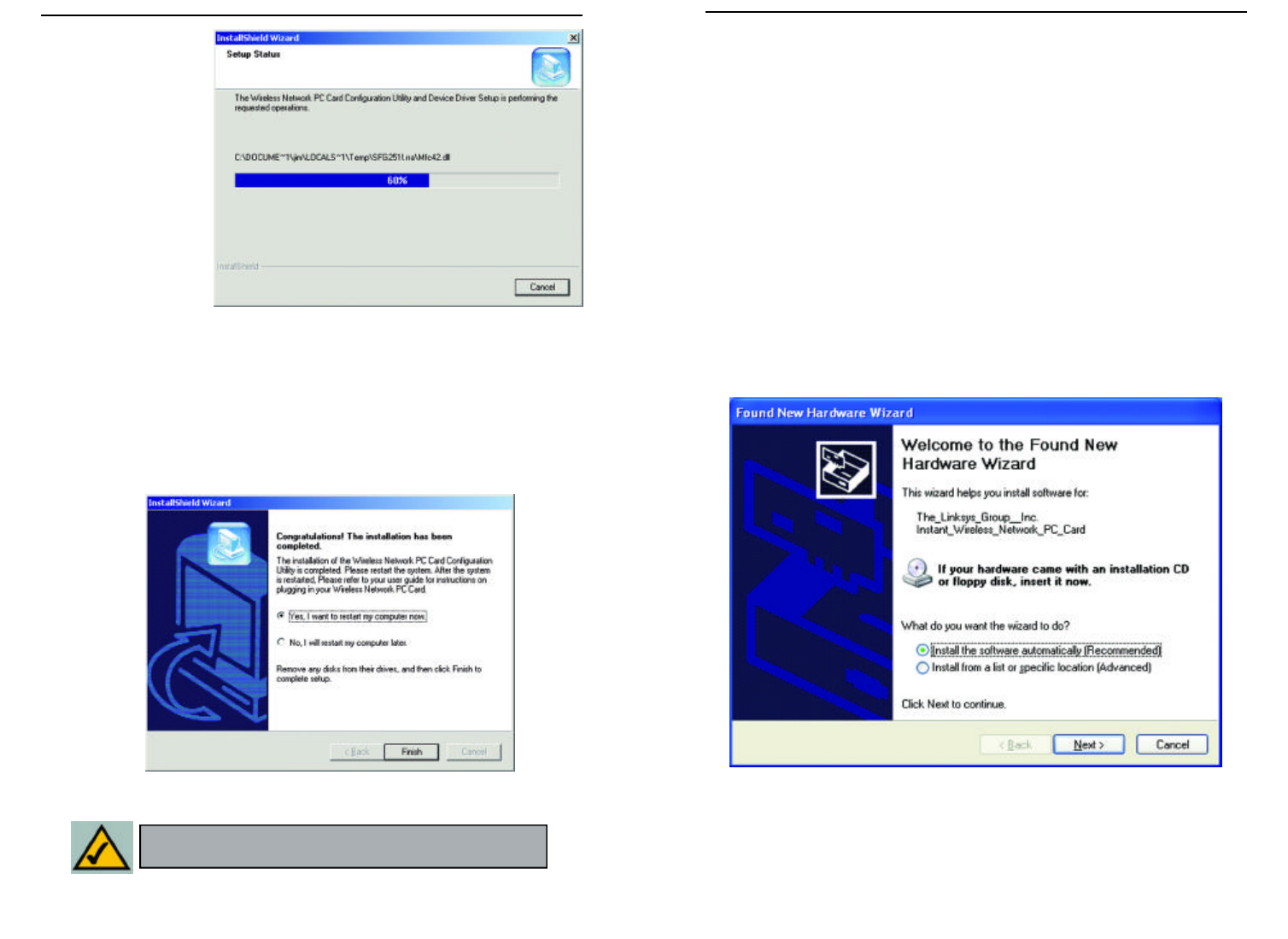
Chapter 4: Installing the Drivers
and Configuration Utility for
Windows XP
Windows XP will automatically walk you through the driver installation
process as well as automatically configure the Network PC Card for your wire-
less network. If you have any questions regarding wireless networking on your
Windows XP PC, please refer to your Windows XP documentation.
To install the Network PC Card’s drivers, insert the Setup Utility CD-ROM into
your CD-Rom drive and then insert the card into your PC’s PCMCIA slot.
Windows XP will automatically detect the card and search for the appropriate
drivers. The screen in Figure 4-1 will then appear.
Verify that the radio button beside Install the software automatically
(Recommended) is highlighted. If not, click it. Then, click the Next button to
continue.
14
4. The next screen
will indicate that all
of the appropriate
files are being
copied onto your
drive. (See Figure
2-16.) Click the
Cancel button if
you need to stop
the installation for
any reason.
5. Once Windows has finished copying the necessary files, a screen similar to
that shown in Figure 2-17 will appear. In order for the drivers to be
installed properly, you must restart your computer. If you choose to do it
now, select Yes, I want to restart my computer now. If you do not want
to do it now, choose No, I will restart my computer later. Once you have
made your choice, click the Finish button to continue.
Network PC Card
Figure 2-16
Figure 2-17
Note: Restart the computer and go to Chapter 5:
Installing the Network PC Card for further instructions.
Figure 4-1
Instant Wireless
TM
Series
13
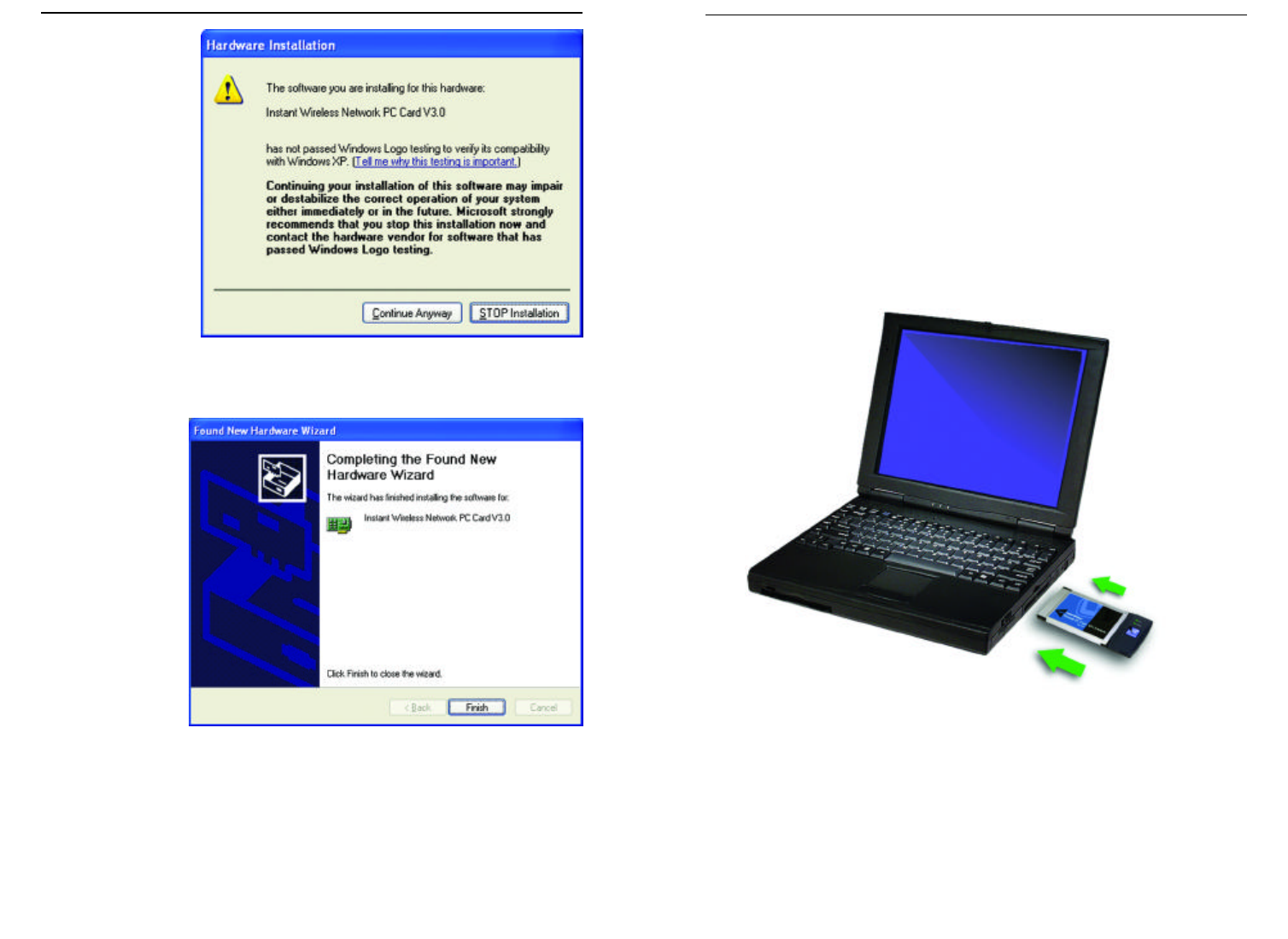
Chapter 5: Installing the Network
PC Card
1.Locate an available Type II or Type III PCMCIA slot on
your notebook computer.
2. With the Network PC Card’s 68-pin connector facing the PCMCIA slot
and the “Network PC Card” label facing up, as shown in Figure 5-1, slide the
Network PC Card completely into the PCMCIA slot while the computer is
restarting and before the Windows desktop appears.
3. You may see several screens appear as the driver installation is finalized.
This is normal. No input should be necessary, and the screens should dis-
appear when the card is ready for use.
The Hardware Installation is complete. Your Wireless Network PC Card
is set up and ready for use. You may continue reading to learn about the
card’s Configuration Utility in Chapter 6 for Windows NT or Chapter 7
for other Windows Operating Systems.
The Windows XP
compatibility screen
will appear, as
shown in Figure 4-2.
As this card has
been tested to work
with Windows XP,
click the Continue
Anyway button to
continue.
On the final instal-
lation screen, click
the Finish button
to complete instal-
lation.
The Hardware Installation is complete.
Windows XP automatically detects and configures the Network PC Card for
your wireless network. To adjust these settings, refer to your Windows XP doc-
umentation.
15
Figure 4-2
Figure 4-3
Instant Wireless
TM
Series
Network PC Card
16
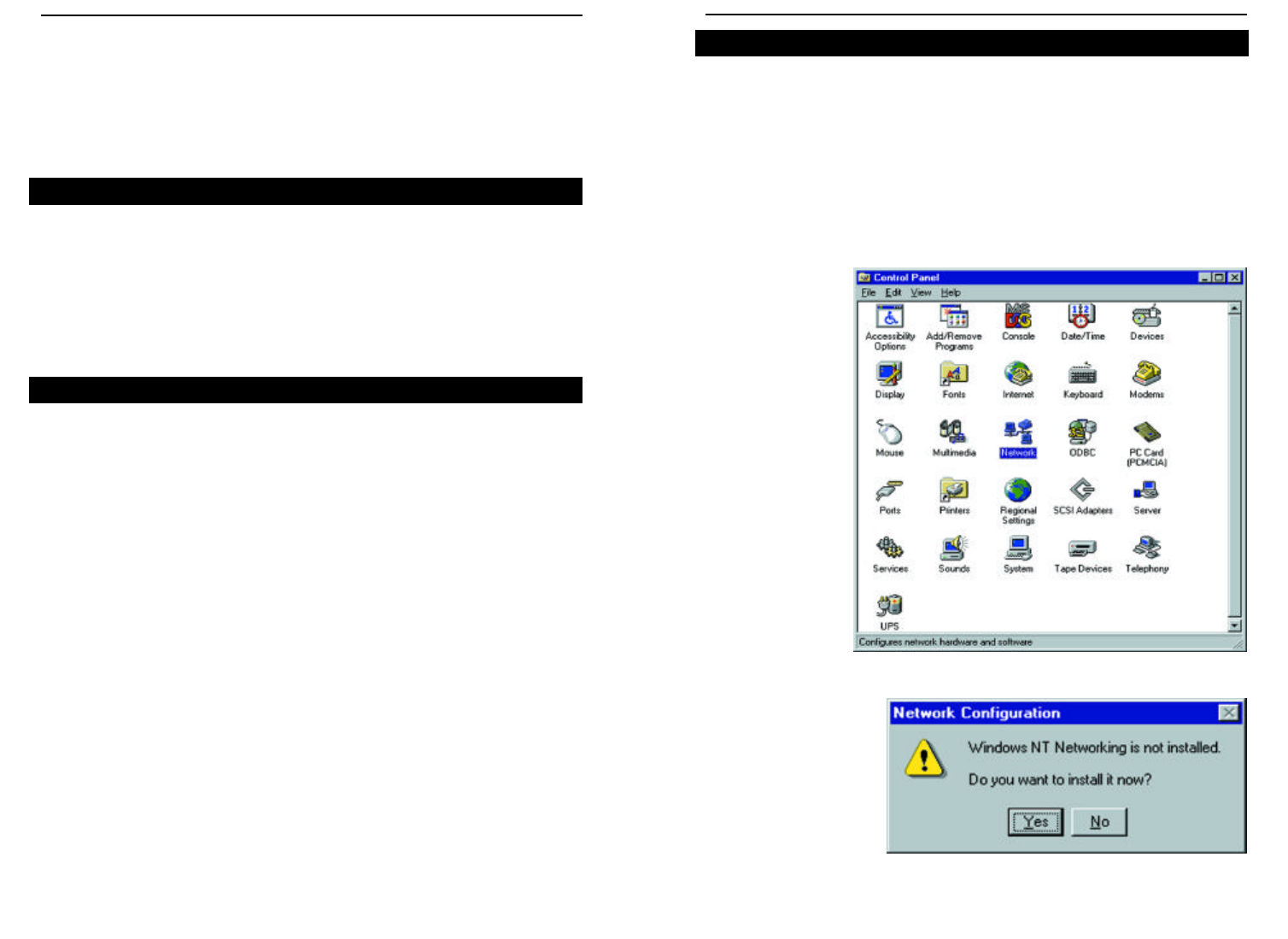
Windows NT will set up the Network PC Card differently depending upon
whether you’ve previously installed network hardware or not. Please follow the
instructions appropriate for you.
If You Have Never Installed Network Hardware:
1. Windows NT is not a Plug-and-Play Operating System and will not auto-
matically identify the Network PC Card. To begin setup, insert the Setup
Utility CD into your CD-ROM drive. If the Setup Utility CD attempts to
autorun, exit out of the utility to the desktop by clicking the Exit tab. Select
Settings from the
Start Menu and
bring up the
Control Panel
(as shown in
Figure 6-1).
Double-click the
Network icon.
2. Windows will display
the screen in Figure 6-
2, showing that
Networking has not
been installed. Click
the Yes button to con-
tinue.
Installing the Drivers for Windows NT
17
Figure 6-1
Figure 6-2
Chapter 6: Installing the Drivers
and Configuration Utility for
Windows NT
The installation of the Network PC Card is different for users of Windows NT
because it is not a Plug-and-Play (PnP) operating system. This means it will not
automatically detect the presence of the Card when it is inserted.
Consequently, the order of the installation is different. The steps involved in
the installation are different, as well. If you are using any other operating sys-
tem than Windows NT, stop here and refer to the chapters regarding those oper-
ating systems.
1. Locate an available Type II or Type III PCMCIA slot on your notebook
computer.
2. With the Network PC Card’s 68-pin connector facing the PCMCIA slot
and the “Network PC Card” label facing up, slide the Network PC Card
completely into the PCMCIA slot while the computer is restarting and
before the Windows desktop appears.
The Hardware Installation is complete. Proceed to the next section for
driver installation.
Overview
Installing the Network PC Card In Your Notebook PC
Network PC Card
Instant Wireless
TM
Series
18
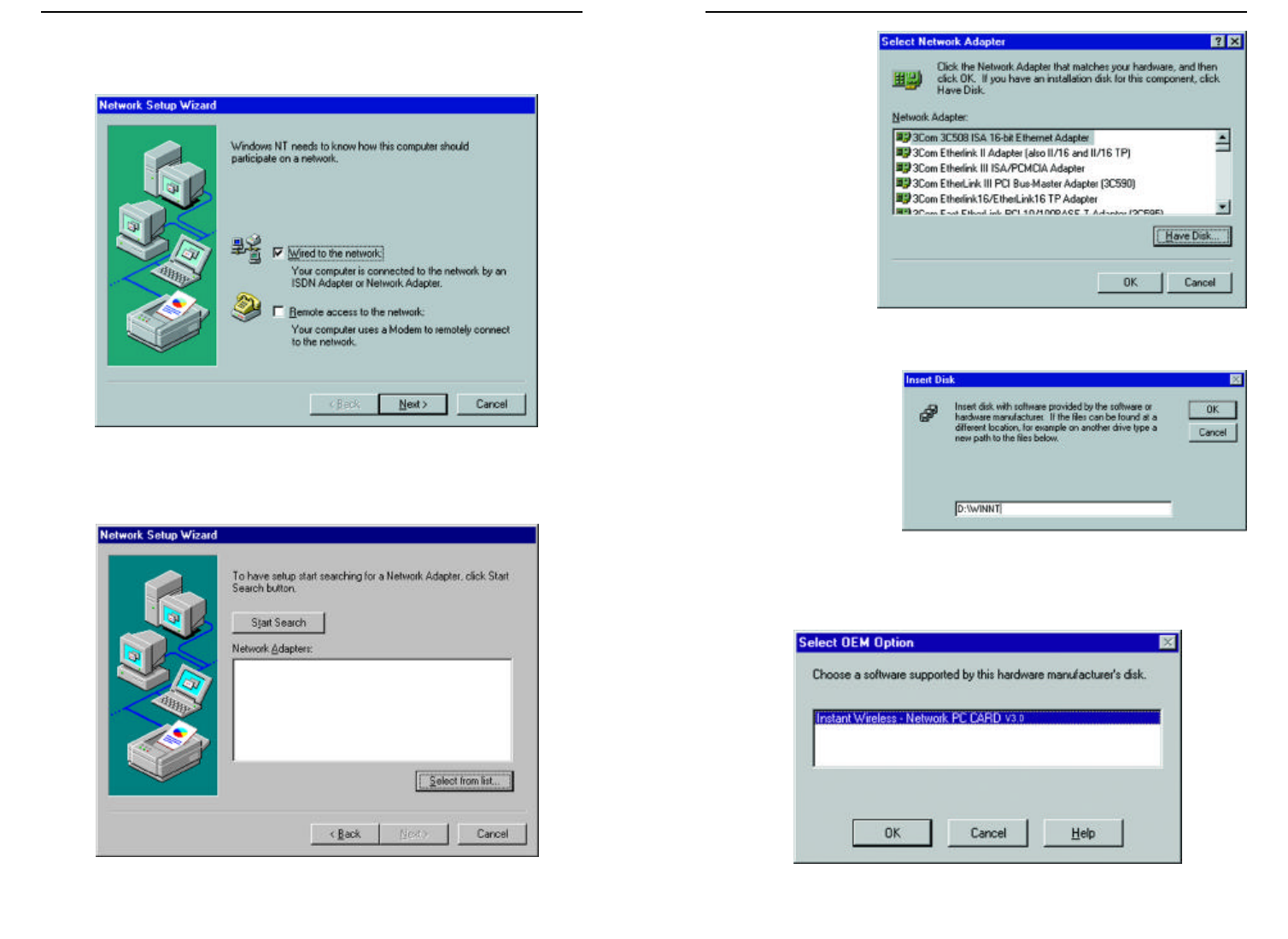
5.A list of adapters
will appear as in
Figure 6-5. You will
not want to select
one of these, howev-
er, as your installa-
tion disk (the Setup
Utility CD) has all
of the appropriate
drivers. Click the
Have Disk button to
continue.
6. When the Insert Disk
screen appears (shown
in Figure 6-6), type
“D:\WINNT” in the
field provided and click
the OK button to con-
tinue.
7.The Select OEM Option screen (shown in Figure 6-7) will display all
available adapters. Make sure that Instant Wireless - Network PC Card
V3.0 is highlighted and click the OK button to continue.
19
Figure 6-5
Figure 6-6
Figure 6-7
3. Installation will begin and you will reach the screen in Figure 6-3. You will
want to select the box that reads Wired to the network since you are adding
network hardware. Click the Next button to continue.
4. The screen shown in Figure 6-4 will not show any Network Adapters
installed on your system; this signifies that no network adapter has been pre-
viously installed. Click the Select from list button to continue.
Network PC Card
Figure 6-3
Figure 6-4
Instant Wireless
Series
20
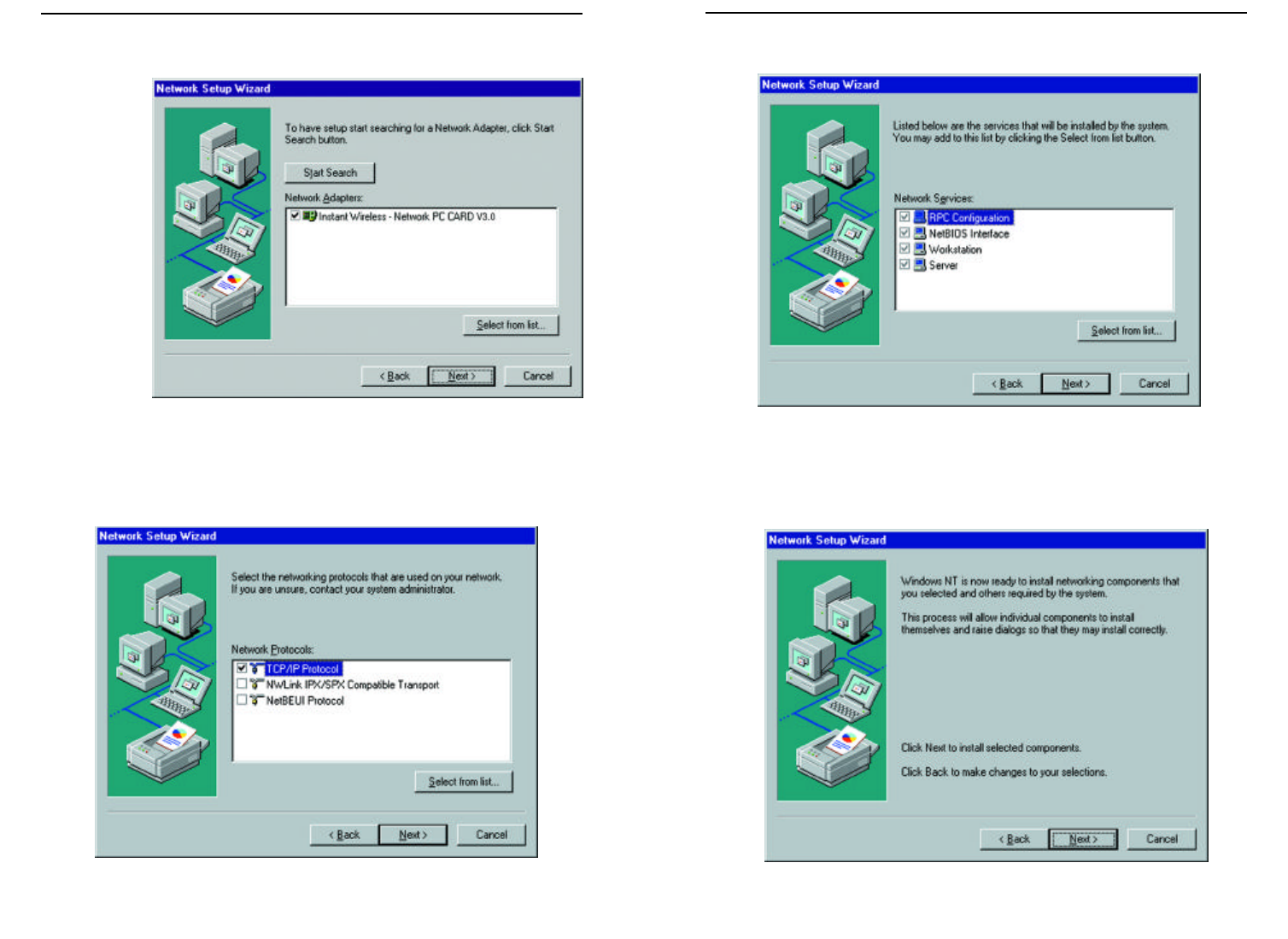
10. On the screen showing Network Services (Figure 6-10), the selections are
automatically made. Click the Next button to continue.
11. As displayed in Figure 6-11, Windows NT will now be ready to start
installing networking components. After verifying your selections, click the
Next button to continue or click the Back button to make any necessary
corrections.
21
Figure 6-10
Figure 6-11
8. On the next screen, make sure there is a check mark in the box beside
Instant Wireless - Network PC Card (as shown in Figure 6-8). Then click
the Next
button to
continue.
9.The next screen (Figure 6-9) will show the list of network protocols used on
your network. While the TCP/IP Protocol is already selected by default, you
should check with your network administrator before installing any addi-
tional network protocols. Click the Next button to continue.
Network PC Card
Figure 6-8
Figure 6-9
Instant Wireless
TM
Series
22
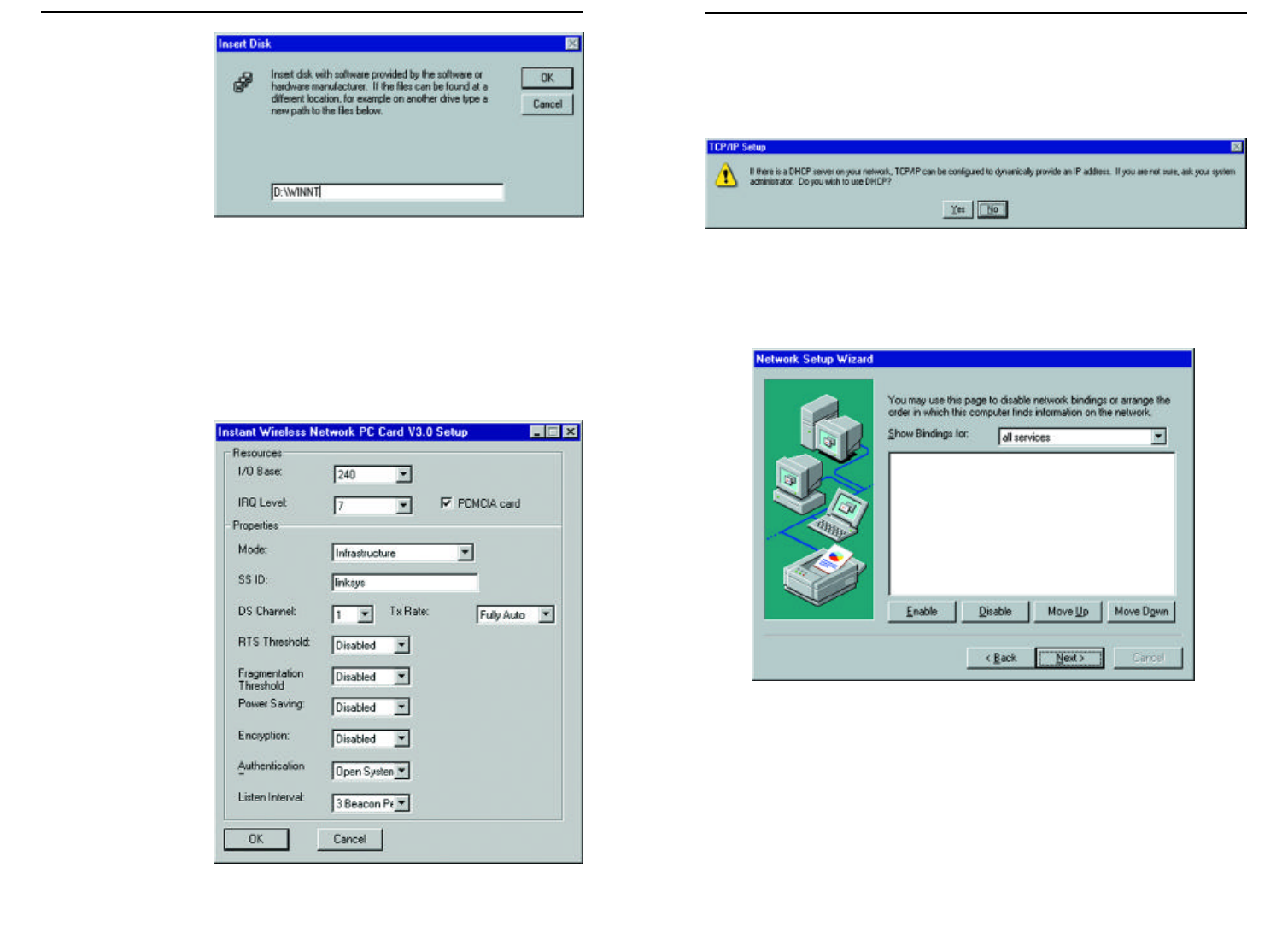
14. After setting the Resource and Properties fields, Windows NT will begin
installing the network components you’ve selected. You may be presented
with the screen shown in Figure 6-14, asking if you would like to configure
the protocols with a DHCP server on your network. Click the Yes or No
button to continue. This setting may also be changed at a later time.
15. In the event that the screen shown in Figure 6-15 appears, do not make any
changes unless you are proficient with the advanced networking properties
of Windows NT. Click the Next button to continue.
16. At this point, Windows NT will let you know that it is ready to start the net-
work. If you’d like to stop the procedure, click the Back button. To contin-
ue, click the Next button.
Figure 6-14
Figure 6-15
12. Windows NT may
request further
files at this point
(as shown in
Figure 6-12). Type
“D:\WINNT”
(where “D” repre-
sents your CD-
ROM drive) in the
field provided and
click the Continue
button.
If files are still requested, insert your Windows NT CD into your CD-ROM
drive and type “D:\i386” (where “D” represents your CD-ROM drive).
Then, click the Continue button.
13. You will now reach the screen shown in Figure 6-13. This is called the
Resources & Properties screen. It is recommended that you leave these
options at their
default settings. If
settings must be
changed, it is pre-
ferred that you use
the Configuration
Utility that came
with the Network
PC Card. If you
must adjust the set-
tings on this screen,
refer to Chapter 9:
Advanced
Properties for more
information on the
Advanced
Properties for
Windows NT. Click
the OK button to
continue.
Network PC Card
Figure 6-12
Figure 6-13
Instant Wireless
Series
23 24
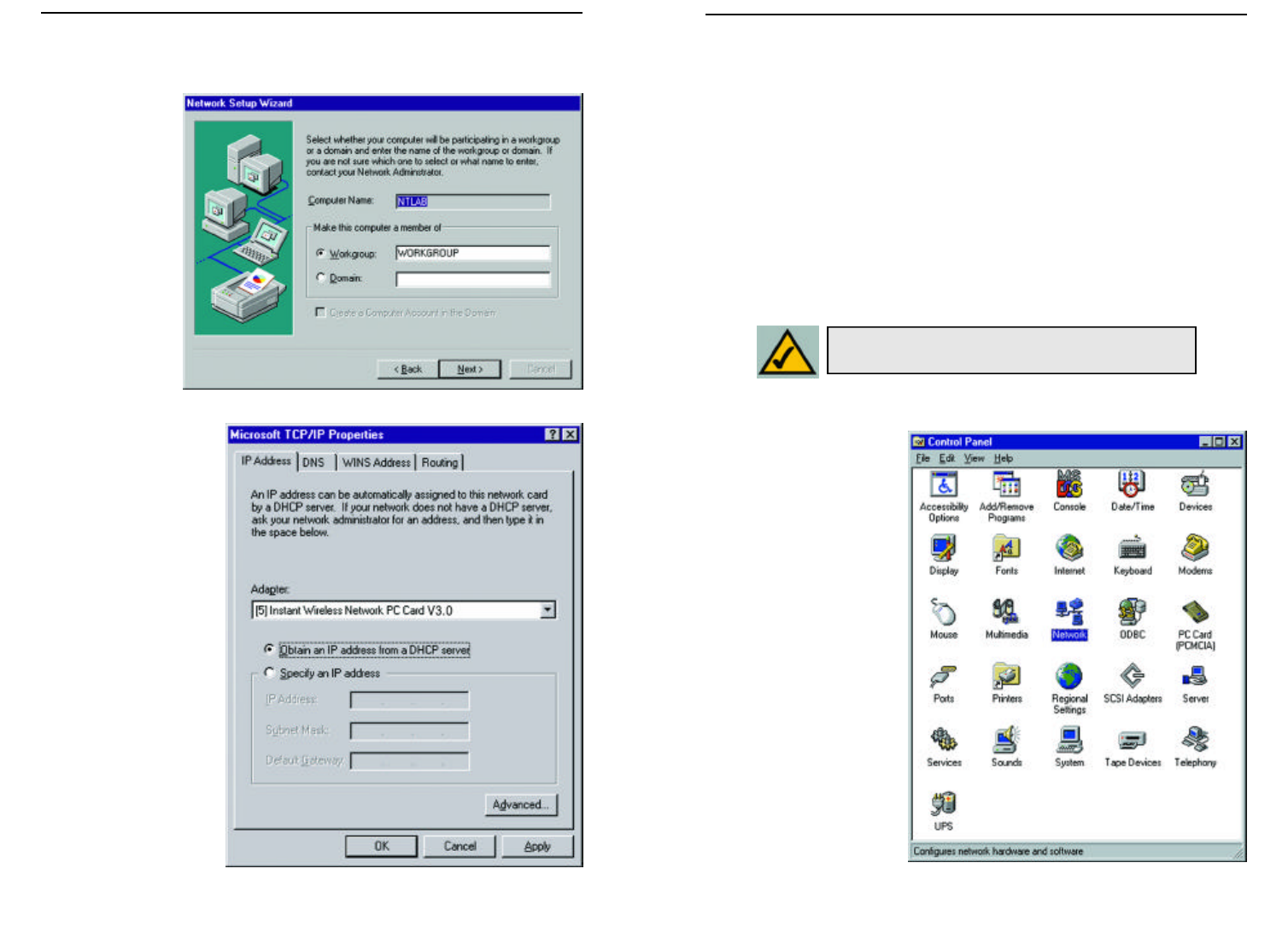
Make sure that the Instant Wireless Network PC Card ver. 3.0 appears in the
Adapter window (as shown in Figure 6-17). Then, unless you need to
assign a static IP address, select Obtain an IP address from a DHCP
server and click the OK button. If you need to assign a static IP address,
select Specify an IP Address, and enter the appropriate values under IP
Address, Gateway Mask, and Default Gateway. After you have made your
choice, click the OK button.
Windows NT has now completed installing the network. Remove the Setup
Utility CD from the CD-ROM drive and click the Finish button to contin-
ue. Then, restart your computer.
The Driver Installation is complete. Continue now to the section called
Installing the Configuration Utility for Windows NT.
If You Have Installed Network Hardware Before:
1. Windows NT is not a
Plug-and-Play Operating
System and will not
automatically identify
the Network PC Card. To
begin setup, insert the
Setup Utility CD into
your CD-ROM drive and
then select Settings from
the Start Menu. Bring
up the Control Panel (as
shown in Figure 6-18)
and double-click the
Network icon.
Note: After you have installed the Network PC
Card, reapply the Windows NT service pack.
Figure 6-18
17. On the screen shown in Figure 6-15, enter your Computer Name, how your
computer is identified on the network. Then, assign the computer to either
a Workgroup or Domain, whichever is appropriate. The Computer Name
must be differ-
ent than any
other on the
Workgroup or
Domain. Click
the Next but-
ton.
18. Once the drivers
have been installed,
the following screen
(Figure 6-17) may
appear.
Network PC Card
Figure 6-16
Figure 6-17
Instant Wireless
TM
Series
25 26
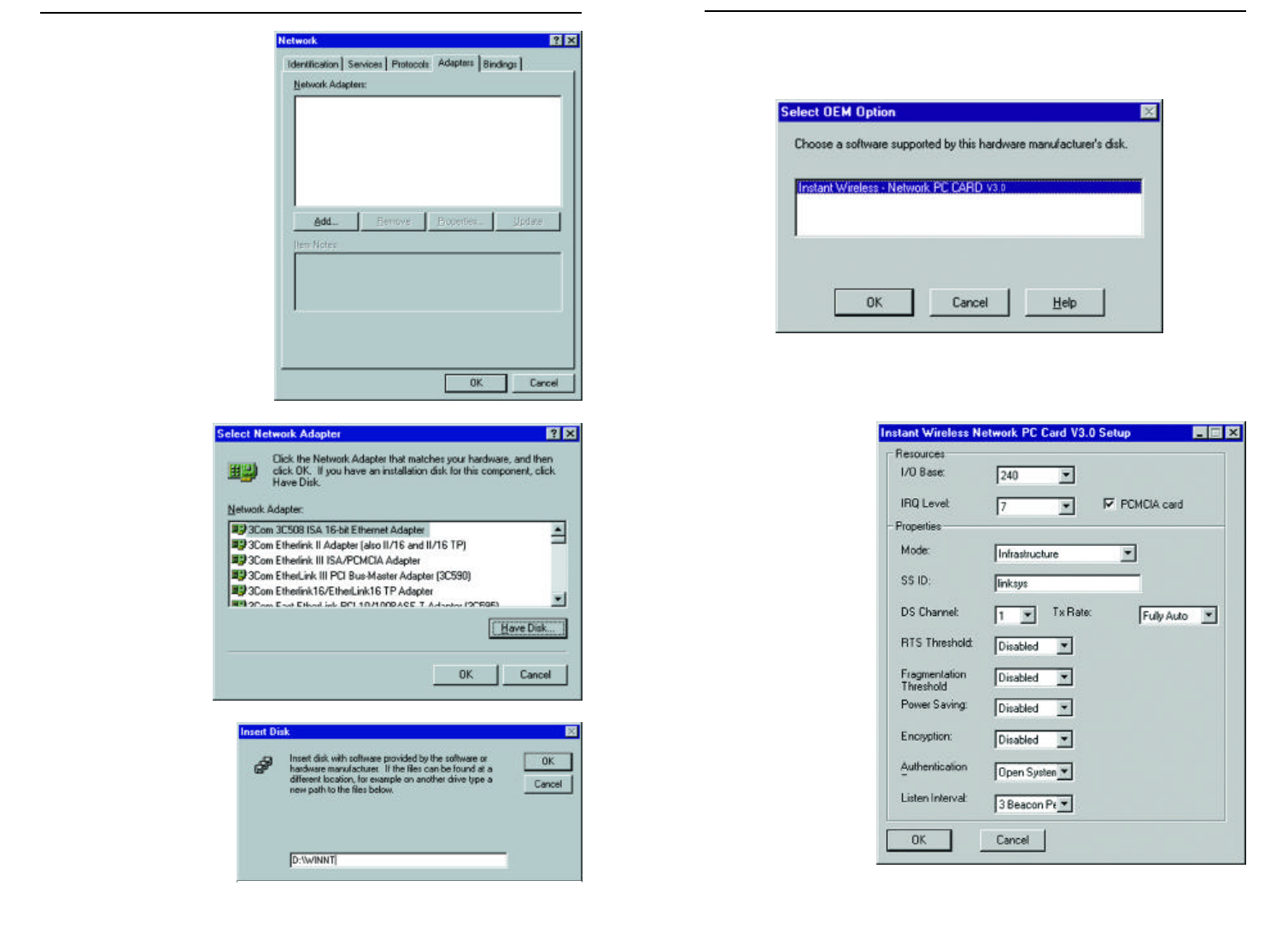
5. The Select OEM Option screen will display all available adapters. Make
sure that Instant Wireless - Network PC Card V3.0 is highlighted, as
shown in Figure 6-22, and click the OK button to continue.
6. You will now reach the screen shown in Figure 6-13. This is called the
Resources & Properties screen. It is recommended that you leave these
options at their
default settings. If
settings must be
changed, it is pre-
ferred that you use
the Configuration
Utility that came
with the Network PC
Card. If you must
adjust the settings on
this screen, refer to
Chapter 9: Advanced
Properties for more
information on the
Advanced Properties
for Windows NT.
Click the OK button
to continue.
Figure 6-22
Figure 6-23
2. To add the Network PC Card,
click the Adapters tab (as
shown in Figure 6-19) and
click the Add button to con-
tinue.
3. A list of adapters
will appear as
shown in Figure 6-
20. You will not
want to select one of
these, however, as
the Setup Utility
CD has all of the
appropriate drivers.
Click the Have Disk
button to continue.
4. On the Insert Disk
screen (Figure 6-21),
type “D:\WINNT” in
the field provided.
Then, click the OK
button to continue.
Network PC Card
Figure 6-19
Figure 6-20
Figure 6-21
Instant Wireless
TM
Series
27 28
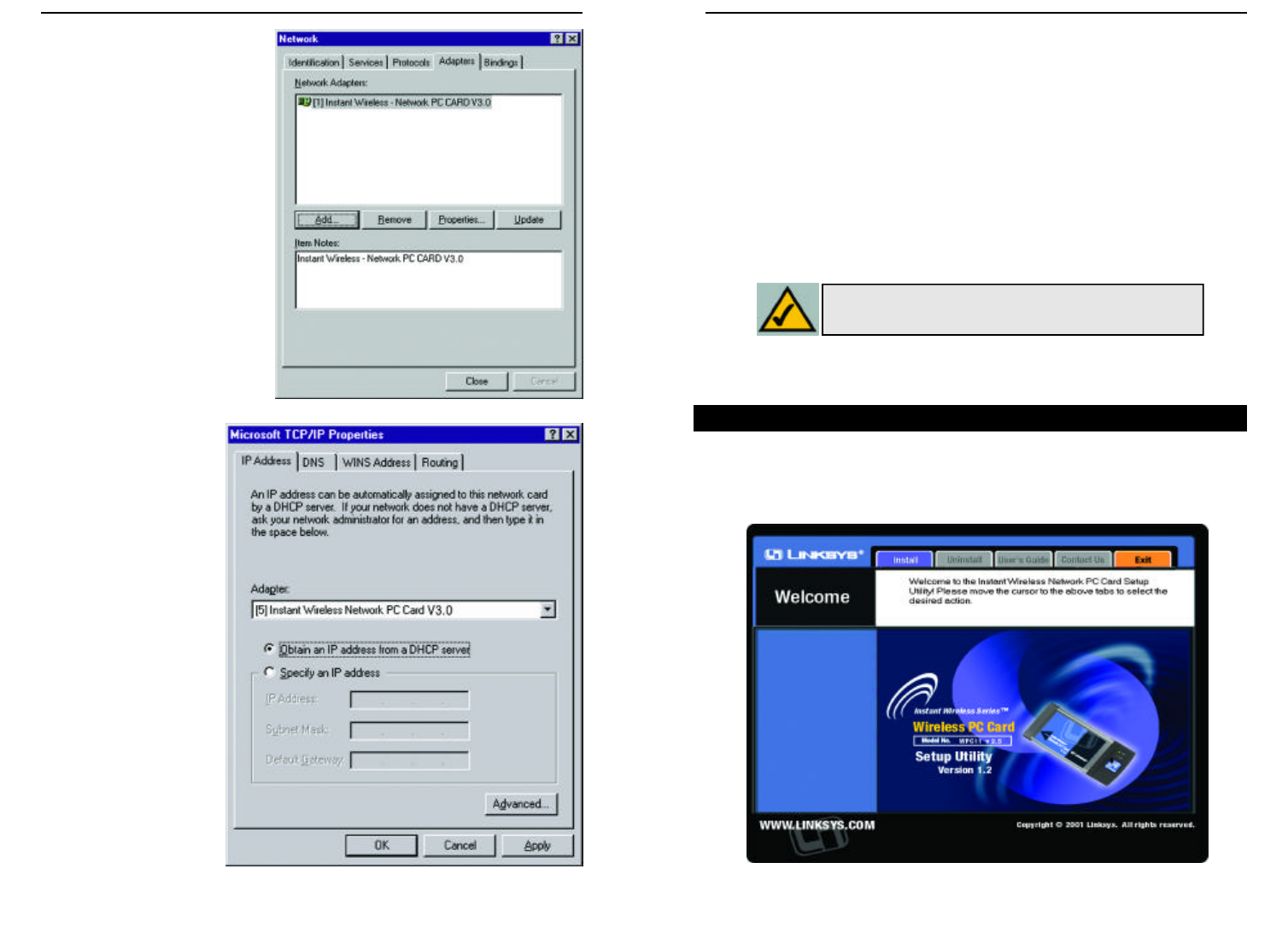
If the screen shown in Figure 4-25 appears, make sure that the Instant Wireless
Network PC Card ver. 3.0 appears in the Adapter window. Then, unless you
need to assign a static IP address, select Obtain an IP address from a DHCP
server and click the OK button. If you need to assign a static IP address, select
Specify an IP Address, and enter the appropriate values under IP Address,
Gateway Mask, and Default Gateway. After you have made your choice,
click the OK button.
Windows NT has now completed installing the drivers. Remove the Setup
Utility CD from the CD-ROM drive and click the Finish button to continue.
Then, restart your computer.
The Driver Installation is complete. Continue now to the section called
Installing the Configuration Utility for Windows NT.
Once you have restarted your computer, the drivers for the Card should load suc-
cessfully. Now it is necessary to install the Configuration Utility. Insert the Setup
Utility CD in the CD-ROM drive. Unless you have deactivated the auto-run fea-
ture of Windows, the screen shown in Figure 6-26 should appear automatically.
NOTE: After you have installed the Network PC Card,
reapply the Windows NT service pack.
Installing the Configuration Utility for Windows NT
Figure 6-26
7. The Network PC Card has
now been installed. You will
see it added onto the screen
shown in Figure 6-24. Click
the Close button to continue
and then restart your comput-
er.
8. Once the drivers have
been installed, the fol-
lowing screen (Figure
6-25) may appear.
Network PC Card
Figure 6-24
Figure 6-25
Instant Wireless
TM
Series
29 30